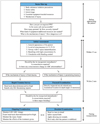Abstract
The educational courses for trauma care are stratified into two classes. The first is the Advanced Trauma Life Support (ATLS) course, which is sponsored by the Committee on Trauma (COT) of the American College of Surgeons (ACS) and whose target learners are the surgeons who treat the victims of major trauma. The second is the Basic Trauma Life Support (BTLS) course, which is sponsored by the American College of Emergency Physicians (ACEP) and whose target learners are the pre-hospital healthcare providers, the nurses in emergency rooms, and the emergency physicians who provide emergency care to the victims of major trauma in the accident scene or in the emergency room before the trauma surgeons. The Emergency Medical Service System (EMSS) of Korea is managing to do its work somewhat well when it functions in the medical emergency situations. However, when it encounters with major trauma patients, it can rarely keep the principles of trauma care, such as the 'Golden Hour' and 'the rapid transportation to an appropriate trauma center directly' due to its systemic failure. Therefore the Preventable Death Rate (PDR) of major trauma patients is presumed to be very high in Korea. To rebuild the EMSS of Korea into a new system suitable for major trauma, the Korean Healthcare Administrations should start to lead the legislation and the support for trauma centers and trauma experts. The spread of the educational courses for trauma care into the emergency medical societies can be a starting point to solve the problem. The BTLS course is one of them.
Figures and Tables
References
1. Pruitt BA, Pruitt JH, Davis JH. Moore EE, Feliciano DV, Mattox KL, editors. History. Trauma. 2004. 5th ed. New York: McGraw-Hill;3–17.
2. American College of Surgeons Committee on Trauma. Advanced Trauma Life Support for Doctors: Student Course Manual. 2004. 7th ed. Chicago: The American College of Surgeons;11–40.
3. Campbell JE. Basic Trauma Life Support for Advanved Providers. 2004. 5th ed. Bloomington: Pearson Education.
4. Hoyt DB, Coimbra R, Potenza BM. Moore EE, Feliciano DV, Mattox KL, editors. Trauma systems, Triage, and Transport. Trauma. 2004. 5th ed. New York: McGraw-Hill;57–77.
5. Korea Institute for Health and Social Affairs. Estimation of loss of income from external causes of mortality: 2000. 2002. Vol 65:Health and Welfare Forum.




 PDF
PDF ePub
ePub Citation
Citation Print
Print









 XML Download
XML Download